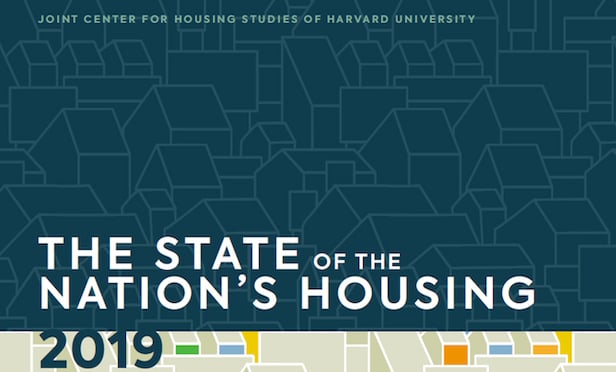 The report states that the number of renter households fell for the second consecutive year in 2018, a stark contrast to the increases the prior 12 years. However, rents are rising at twice the rate of overall inflation.
The report states that the number of renter households fell for the second consecutive year in 2018, a stark contrast to the increases the prior 12 years. However, rents are rising at twice the rate of overall inflation.
CAMBRIDGE, MA—A recently released report by the Harvard Joint Center for Housing Studies states that household growth is now back from post-recession lows, but new home construction continues to fall short of demand.
The “State of the Nation's Housing 2019″ report released earlier this week at the Federal Reserve Bank of Atlanta found several factors that may be contributing to the slow construction recovery, including excess supply following the housing boom, which took years to absorb, and persistent labor shortages.
“The most significant factors, however, are rising land prices and regulatory constraints on development,” says Chris Herbert, managing director of the Harvard Joint Center for Housing Studies. “These constraints, largely imposed at the local level, raise costs and limit the number of homes that can be built in places where demand is highest.”
Another trend in the homebuilding sector is that a majority of new housing is being built primarily for the higher-end of the market. The limited supply of smaller, more affordable homes in the face of rising demand suggests that the rising land costs and the difficult development environment make it unprofitable to build for the middle market, Herbert states.
The report states that the number of renter households fell for the second consecutive year in 2018, a stark contrast to the increases the prior 12 years. However, rents are rising at twice the rate of overall inflation.
“The growing presence of higher-income renters has helped keep rental markets stable,” says Daniel McCue, a senior research associate at the center. “This has maintained demand for new apartments, even as overall rental demand has waned.” At the lower end of the market, though, the number of units renting for under $800 fell by 1 million in 2017, bringing the total loss from 2011–2017 to 4 million.
Even as the market continues to lose lower-cost rental units, the share of US households paying more than 30% of their income for housing declined for the seventh straight year in 2017.
However, much of the progress was among homeowners, though, whose cost-burden rate declined to its lowest level this century, the report states. Cost- burden rates for modest-income renter households, however, continue to rise.
The report authors predict that millennials and baby boomers will continue to push household growth, sparking demand in the remodeling market and the demand for entry-level homes.
Rental growth is expected to be solid with 400,000 additional renter households per year expected between 2018 and 2028. Key factors that are driving those predictions include economic conditions, housing affordability and the pace of foreign immigration.
One big question the report authors pose is whether the market can supply housing that is within reach of most household incomes?
“To ensure that the market can produce homes that meet the diverse needs of the growing US population, the public, private, and non-profit sectors must address constraints on the development process,” says Herbert. “And for the millions of families and individuals who struggle to find housing that fits their budget, public efforts will be necessary to close the gap between what they can afford and the cost of producing decent housing.”
Some of the key data points and takeaways from the report include”
• Although up 3.2% last year to 875,800 units, single-family housing starts remained below the 1.0-million mark for the 11th consecutive year in 2018.
• Housing production barely kept pace with household growth for most of the past decade. In eight of the nation's 50 largest metros, the growth in households exceeded the number of housing permits issued between 2007 and 2017.
• Rising land prices and a shrinking labor pool are two factors for the lack of middle-market housing; the median price per acre of residential land used for existing single-family homes nationwide jumped from $159,800 in 2012 to $203,200 in 2017 (27%).
• The construction industry relies on an increasingly limited labor pool where one out of three trades workers are immigrants and 11 out of 12 do not have bachelor's degrees.
• The inventory of existing homes on the market increased at the end of 2018 for the first time since 2015 to 1.53 million units—a jump of 4.8% from a year earlier. Even so, for-sale inventories remain historically low.
• Year-over-year home price growth slowed nationwide from 6.9% on average in the first three quarters of 2018 to 6.0% in the last quarter.
• In 2018, the national median sales price for an existing home in 2018 was more than 4.1 times the median household income.
• The US homeownership rate edged up again last year. After falling 5.6 percentage points between 2004 and 2016, the national rate increased 0.5 percentage point in 2017–2018, to 64.4%— roughly on par with the average rate in 1985–1995 before the latest housing boom and bust.
• The median sales price of an existing home hit $259,300 in 2018, up from $177,400 in 2011. Adding to affordability pressures, the average rate on a 30-year fixed-rate mortgage also rose to 4.54%—higher than any annual reading since 2010.
• Fueled by rapidly rising home prices and modest increases in mortgage debt, the aggregate value of home equity more than doubled between 2011 and 2018.
• Rents nationwide continued to climb in 2018, up 3.6% for the year.
• Rental housing construction remained strong in 2018. Even after a 5% dip last year, the number of completed rentals was close to a 30-year high at 360,000 units.
Want to continue reading?
Become a Free ALM Digital Reader.
Once you are an ALM Digital Member, you’ll receive:
- Breaking commercial real estate news and analysis, on-site and via our newsletters and custom alerts
- Educational webcasts, white papers, and ebooks from industry thought leaders
- Critical coverage of the property casualty insurance and financial advisory markets on our other ALM sites, PropertyCasualty360 and ThinkAdvisor
Already have an account? Sign In Now
*May exclude premium content© 2025 ALM Global, LLC, All Rights Reserved. Request academic re-use from www.copyright.com. All other uses, submit a request to [email protected]. For more information visit Asset & Logo Licensing.








